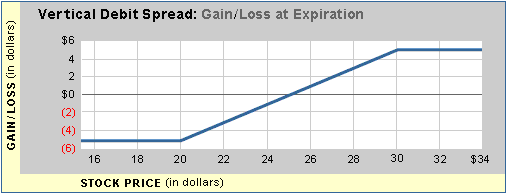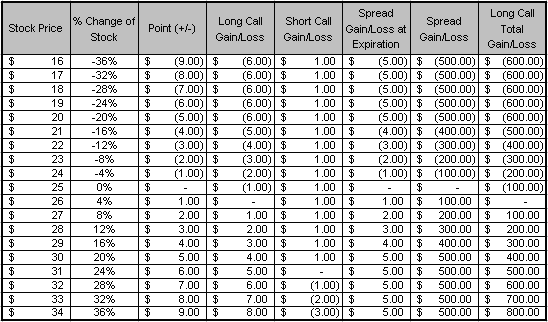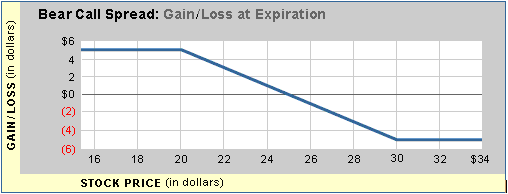
A strategy consisting of the purchase of a call option with one expiration date and strike price and the simultaneous sale of another call with the same expiration date, but a different strike price. Depending on whether the purchased call has a higher or lower strike than the sold call, a vertical call spread can generally be profitable if the underlying stock or index rises (a bull vertical call spread) or falls (a bear vertical call spread) sufficiently.
A Bull Spread strategy may allow an investor to profit from upward movements in the underlying security. The technique requires the investor to purchase at-the-money or in-the-money calls at a particular strike price and sell out-of-the-money calls at a higher strike price with the same expiration date. The cost of purchasing the call option will be partly offset by the premium received for the sale of the out-of-the-money call. This strategy is often termed a debit spread because of the net capital outlay that is required. A Bull Spread delivers maximum profit when the stock trades at or above the higher strike price at expiration.
For use when investor anticipates:
Financial Characteristics:
Objective*:
*The maximum loss on a spread position remains limited to premium outlay as long as, and only as long as, the integrity of the spread is maintained. If the investor trades out of or exercises the low-strike call, the maximum loss is no longer limited to the premium outlay.
EXAMPLE (Bull Vertical Call Spread)
Currently, XYZ trades at $25/share. The investor believes the stock will appreciate and wants to participate in the upward movement, but does not want to simply buy calls because of the expense/risk involved. Instead, the investor employs the spread strategy buying an in-the-money call (strike $20) for $6.00/share and selling an out-of-the-money call (strike $30) for $1.00/share. Using this strategy, the maximum loss is the difference between the premiums paid and the premiums received ($5 or $500). The maximum profit an investor can receive is the difference of the strike prices less the cost of the position. The breakeven price of 25 is calculated by adding the net debit of the spread to the strike price of the long option.

As can be seen from the following chart and table, the investor who buys the spread rather than simply investing in the call reduces his maximum loss by 1/6th, breaks even at $25 instead of $26, and only loses out to the call buyer if the stock price rises above 31 (at which point he would have a 100% return on his investment).
Spread vs. Long Call


In a Bear Call Spread, an investor performs the exact opposite transactions as those used in the Bull Call Spread. Because the investor maintains a negative outlook on the underlying security, he sells in-the-money calls and buys out-of-the-money calls at a higher strike price but sharing the same expiration. This strategy is often termed a credit spread because of the net inflow of capital received when the investor establishes the position. As a result, if the value of the security falls below the strike price of the written call at expiration, the investor will retain the initial amount received to establish the spread. However, if the security increases in value, the investor may suffer a loss. The spread strategy caps the maximum value of this loss at the difference between the two option strike prices involved in the transaction, less the net premium received when putting on the spread*.
For use when investor anticipates:
Financial Characteristics**:
Objective*:
*The maximum loss on a bear call spread is limited as long as, and only as long as, the integrity of the spread is maintained. If the investor trades out of or exercises the high-strike call, the maximum loss is no longer limited. There is an additional risk associated with the expiration weekend. If the short call is assigned, while the long is not (exercised, for example, the stock finishes between the two strikes) the investor ends up with a short position in the stock. Good news during the weekend could force even greater losses on the investor before he can exit the short equity position.
** A margin account is required
EXAMPLE (Bear Vertical Call Spread)
Currently, XYZ trades at $25/share. The investor believes the stock will fall and wants to earn income but does not want to simply sell calls because of the risk involved. Instead, the investor employs the Bear Spread strategy selling an in-the-money (strike $20) call for $6.00/share and buying an out-of-the-money (strike $30) call for $1.00/share. Using this strategy, the maximum loss is the difference between the option strikes, less the call premium received (30-20-5 = $5 or $500)* (see * above). The maximum profit an investor can receive is the premium received from selling the call less the premium paid for the out-of-the-money call (6-1 = $5 or $500). The breakeven price of 25 is calculated by adding the net credit of the spread, to the strike price of the short option.

Commissions, taxes, and transaction costs are not included in any of these strategy discussions, but can affect final outcome and should be considered. Please contact a tax advisor to discuss the tax implications of these strategies. Many of the strategies described herein require the use of a margin account. With long options, investors may lose 100% of funds invested. In-the-money long puts need to be closed out prior to expiration, since exercising them could create short stock positions.
Options carry a high level of risk and are not suitable for all investors. Certain requirements must be met to trade options through Schwab. Multiple leg options strategies will involve multiple commissions. Please read the options disclosure document titled "Characteristics and Risks of Standardized Options." Member SIPC
Copyright ©Charles Schwab & Co., Inc. 2011. All rights reserved. Member SIPC. (0411-2708)